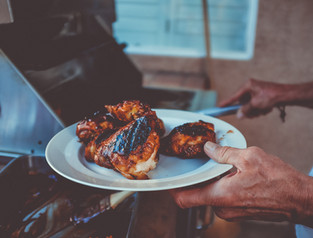Food Stats: Chicken
- Linked Fit

- Jan 21, 2021
- 3 min read
Updated: Mar 2, 2021
Overview:
The chicken we purchase and consume comes from the animal source, chicken.
Of all the birds, domesticated chickens are one of the most popular, making them a global food source.
Chicken is a well-known, high protein source used by many cultures in multitudes of different dishes.
Chickens are thought to have originated from South, Southeast, and East Asia regions
Chickens belong to the order of Galliformes. This order is directly linked to the birds that survived when the dinosaurs went extinct!
Chicken is fairly inexpensive meat but provides a great high-quality source of protein.

The Look:
Chicken in the raw has a pinkish tint to it.
When cooked, it should be plump and now more towards the color of white if no seasoning or breading is on it. When cut open to check to see if it's cooked, it should not be pink inside.
If a piece of chicken has the skin still on it when cooked it should crisp up and turn a brown color.
You can purchase chicken whole, ground, or buy pre-cut sections of chicken like the thighs and breasts.
Chicken can also come skinned or skinless. Most of the fat in chicken is found in the skin, which can be removed if purchased with it.
Chicken also has sections of white and darker-colored meat. Both contain more or less of the nutrients found in chicken.
Nutrition:
High in protein
B-Complex vitamins
Magnesium
Potassium
Phosphorus
Zinc
Benefits:
Protein is critical to so many processes in the body! Protein plays a part in the function, structure, and regulations of bodily tissues and organs.
B vitamins play many roles in the human body. They are water-soluble and take part in keeping the body’s cellular metabolism on track in working efficiently.
Magnesium is a component of bones and plays a role in nerve impulse transmission and protein synthesis.
Potassium is generally associated with low blood pressure and lowering the chance of stroke.
Phosphorus is a structural component of teeth, bones, cell membranes, phospholipids, nucleic acids, and more. Phosphorus plays a role in pH regulation and ATP-ADP phosphate systems in cells.
Zinc plays a large role in metabolizing other nutrients and collagen formation. Zinc works to detoxify alcohol, eliminate carbon dioxide, and promotes cell replication and growth.
Serving Size
4 ounces of cooked chicken contains about 137 calories
About 0 grams of carbohydrates
About 21.1 grams of protein
About 5.7 grams of fat
About to 0 grams of fiber
About 55.2 mg of cholesterol
About 180.6mg of sodium
Use & Cooking
Chicken has such a plethora of uses it's hard to list them all!
It can be baked, fried, pan-seared, grilled, air fried, crock-pot cooked, and more.
Season with just about any seasoning, herb, and spice to flavor the needs of your dish.
Based on how it's cooked it can be used in many different dishes. If it’s grilled it's usually served over top of a dish while if used in a crockpot, it might have many other accompanying ingredients to make a stew, soup, or casserole-style dish.
Storage:
Raw chicken lasts approximately 1 week at maximum in the fridge depending on when it was packaged and purchased.
Cooked chicken can last up to 5-6 days refrigerated.
Not planning to cook your meat right away? Store in the freezer and defrost in the fridge when looking to use.
Recipes:
Stews, soups, and casserole-style dishes are a go-to, easy recipe for chicken and are able to be made in large quantities to last you all week!
Chicken can also be a staple in delicious Mexican-themed dishes such as tamales or burritos and burrito bowls.
Chicken is popularly deep-fried as well! Boneless and boned wings are breaded, deep-fried, and can be served with a multitude of sauces and spices.
Grilled chicken is as simple as it sounds and can be made alone or in a stir-fry to make in big amounts for your week ahead!
Gropper, S. A., Smith, J. L., & Groff, J. L. (2018). Advanced Nutrition and Human Metabolism (Sixth ed.). Boston, MA: Cengage Learning.
4oz Chicken Breast. (n.d.). Retrieved January 05, 2021, from http://www.foodpro.huds.harvard.edu/foodpro/label.asp?locationNum=03










Comments